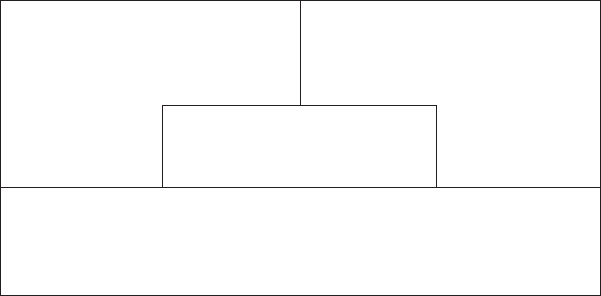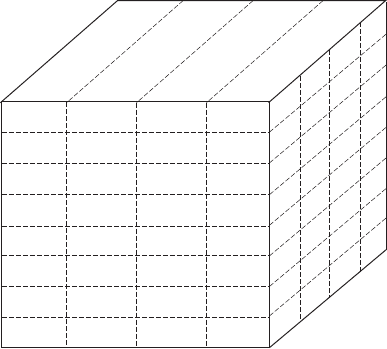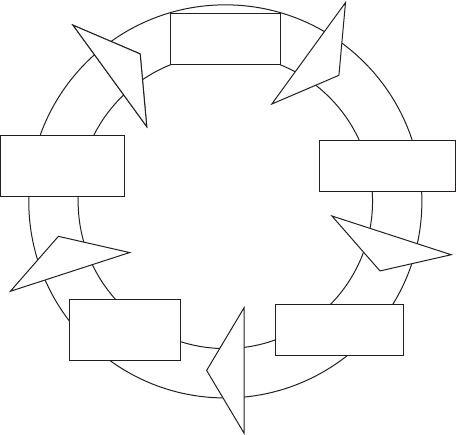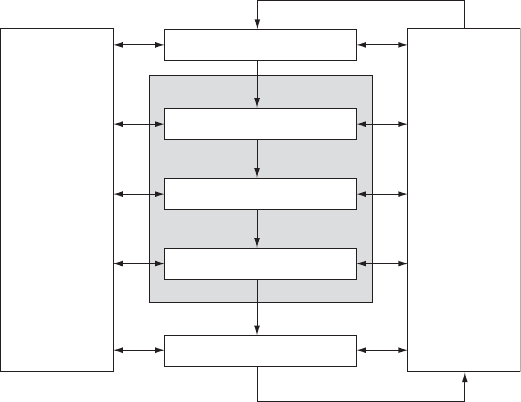Paul Hopkin. Fundamentals of Risk Management
Подождите немного. Документ загружается.


54 Introduction to risk management
Table 6.1 Risk management standards
Standard Description Reference
ISO 31000 Standard published by the International
Standards Organization (2009)
Figure 6.5
British Standard
BS 31100
Standard published by British Standards
Institution (2008)
Figure 6.4
Institute of Risk
Management (IRM)
Standard produced jointly by AIRMIC, Alarm
and the IRM (2002).
Figure 6.1
COSO ERM
Framework produced by the Committee of
Sponsoring Organizations of the Treadway
Committee (2004)
Figure 6.3
Turnbull Report
Framework produced by the Financial
Reporting Council (2005)
Chapter 6
Orange Book Standard produced by HM Treasury of the UK
Government (2004)
Chapter 6
CoCo
(Criteria of Control)
Framework produced by the Canadian Institute
of Chartered Accountants (1995)
Figure 31.1
One of the best-established and most widely used risk management standards was produced
by the IRM in 2002 in co-operation with AIRMIC and Alarm. The IRM Standard is a high
level approach aimed at non-risk-management specialists and it has been translated into many
languages. The Australian Standard and the COSO standard/framework are designed for use
primarily by specialist risk management practitioners. The IRM Standard is available as a free
download from the IRM website, and the risk management process used in it is reproduced in
Figure 6.1.
For organizations that are listed on the New York stock exchange, the approach outlined in the
COSO Internal Control framework (1992) is recognized by the Sarbanes–Oxley Act of 2002
(SOX). The requirements of SOX also apply to subsidiaries of US-listed companies around the
world. Therefore, the COSO approach is internationally recognized and, in many circum-
stances, mandated. It is worth noting that SOX requires the approach described in the COSO
Internal Control framework (1992). This is not the same as the COSO ERM framework (2004)
described later, although the COSO ERM framework does contain all of the elements of the
earlier Internal Control version.
The COSO Internal Control framework has become the most widely used internal control
framework in the United States and it has been adapted and/or adopted by numerous coun-
tries and businesses around the world. An enterprise risk management (ERM) version of the

Risk management standards 55
The Risk Management Process
The Organization’s
Strategic Objectives
Risk Reporting
Threats and Opportunities
Risk Assessment
Risk Evaluation
Risk Analysis
Risk Identication
Risk Description
Risk Estimation
Decision
Risk Treatment
Residual Risk Reporting
Monitoring
Modication
Formal Audit
Figure 6.1 IRM risk management process
IRM/AIRMIC/ALRAM 2002
COSO framework was produced in 2004 and this has both risk management and internal
control within scope.
Apart from the British, ISO and COSO standards, a number of others are also well regarded
and in widespread use. The UK’s Turnbull guidance was updated in 2005 and is considered by
the Securities and Exchange Commission (SEC) in the United States to be an acceptable alter-
native to the COSO Internal Control framework for Sarbanes–Oxley compliance. The updated
Turnbull guidance can be found as a free download from the website of the Financial Report-
ing Council.
As well as the established standards and frameworks, a considerable amount of guidance on
risk management has been published by various government departments. HM Treasury in
the UK has published the highly respected ‘Orange Book’, which contains a signifi cant amount
of useful information on risk management tools and techniques. Many of the ideas and con-
cepts presented in the Orange Book are referenced throughout this volume.
56 Introduction to risk management
Some of the available standards were developed by risk management professionals, whilst
others were developed by accountants or auditors. There are three distinct approaches fol-
lowed in the various standards:
‘risk management’ approach followed by ISO 31000, British Standard BS 31100 and •
the IRM Standard;
‘internal control’ approach developed by COSO Internal Control framework and by •
the Turnbull Report;
‘risk-aware culture’ approach developed by the Canadian Institute of Chartered •
Accountants, known as the CoCo framework.
Risk management process
A simple representation of the risk management process is provided by Figure 4.1 (page 40)
and a similar process is contained in all of the established risk management standards. Many
of the standards distinguish between the risk management process and the framework that
supports the process. However, this distinction is not always clear in many of the established
risk management standards/frameworks.
The best-established risk management approaches are the IRM Standard, ISO 31000, BS
31100, and the COSO ERM framework. All four provide a description of a risk management
framework, but more emphasis is placed on the risk management process in the IRM Stand-
ard, ISO 31000 and BS 31100. The COSO approach does not provide the same clear distinc-
tion between the framework and the risk management process itself and is mainly concerned
with framework considerations.
Several countries have developed their own internal control and risk management standards
as part of their requirements for being listed on a stock exchange. Typically, these are frame-
works similar to COSO Internal Control in approach, and this is certainly the case with the
Turnbull requirements that exist in the UK.
Although there are many ways of representing the risk management process, the basic steps
are all similar. There can be diffi culties with the terminology that is used to describe the various
steps, and Appendix A provides defi nitions of basic terms, as well as cross-referencing the dif-
ferent terminologies that can be used.
Risk management framework
There are many risk management standards and risk management frameworks that have been
produced by various organizations. It is generally acknowledged that a standard is a document

Risk management standards 57
that produces information on both the risk management process and the risk management
framework.
Within many risk management standards, risk management activities should take place within
the context of the business environment, the organization and the risks faced by the organiza-
tion. In order for the context to be described and defi ned, a framework is required to support
the process. ISO 31000 places particular emphasis on context and states that consideration
should be given to the internal context, external context and risk management context when
undertaking risk management activities.
All of the established risk management standards refer to the risk management framework,
although this is represented in different ways. In order to provide a simple explanation of the
scope of the risk management framework, the acronym Risk Architecture, Structure and Pro-
tocols (RASP) has been developed. Figure 6.2 illustrates the key features of a risk management
framework that is built around and supports the risk management process.
Part 2 of this book describes the risk architecture, strategy and protocols (RASP) in more
detail. It is the risk architecture strategy and protocols that defi ne the framework within which
the risk management process takes place. These three components of architecture, strategy
and protocols are required for successful risk management activities. There needs to be a clear
understanding of the risk management process, followed by a clear defi nition of the frame-
work that supports the process. Also, the risk-aware culture within the organization needs to
be strong.
In supporting the risk management process, the risk management framework needs to facili-
tate communication and the fl ow of risk information. Because the framework is a supportive
structure, it is shown in Figure 6.2 as a series of components built around and supporting the
risk management process.
For example, an organization might decide to follow the structure of the IRM Risk Manage-
ment Standard. The company would then have to set up a framework that includes the
Risk architecture
Risk architecture denes roles,
responsibilities, communication and
risk reporting structure
Risk protocols
Risk protocols are dened in the risk guidelines for the organization and include the
rules and procedures, as well as the risk management methodologies, tools and
techniques that should be used
Risk strategy
Risk strategy, appetite, attitudes and
philosophy are dened in the risk
management policy
Risk management process
Figure 6.2 Components of an RM framework

58 Introduction to risk management
structure, responsibilities, administration, reporting and communication components of risk
management. All of these procedures will then be recorded in a risk management policy.
COSO ERM cube
An Enterprise Risk Management (ERM) version of the COSO framework was produced in
2004 and this has both risk management and internal control within scope. Details of the
COSO ERM framework are provided on the COSO website and there is a free download of the
executive summary of COSO ERM. The COSO ERM approach suggests that enterprise risk
management is not strictly a serial process, where one component affects only the next. It is
considered to be a multidirectional, iterative process in which almost any component can and
does infl uence all other components.
In the COSO ERM framework, there is a direct relationship between objectives, which are
what an entity strives to achieve, and enterprise risk management components, which repre-
sent what is needed to achieve them. The relationship is depicted in a three-dimensional
matrix, in the form of a cube, which is reproduced as Figure 6.3.
The COSO ERM cube is a very infl uential risk management framework and it consists of eight
interrelated components. These are derived from the way management runs an enterprise and
are integrated with the management process. A brief description of the COSO ERM compo-
nents is set out in Table 6.2.
Internal Environment
Objective Setting
Event Identication
Risk Assessment
Risk Response
Control Activities
Information & Communication
Monitoring
SUBSIDIARY
BUSINESS UNIT
DIVISION
ENTITY-LEVEL
STRATEGIC
OPERATIONS
REPORTING
COMPLIANCE
Figure 6.3 COSO ERM framework
COSO’s ERM ‘Cube Diagram’

Risk management standards 59
Table 6.2 COSO ERM framework
Internal environment • – The internal environment encompasses the tone of an
organization and sets the basis for how risk is viewed and addressed.
Objective setting
• – Objectives must exist before management can identify potential
events affecting their achievement.
Event identifi cation
• – Internal and external events affecting achievement of
objectives must be identifi ed, distinguishing between risks and opportunities.
Risk assessment
• – Risks are analysed, considering likelihood and impact, as a basis
for determining how they should be managed.
Risk response
• – Management selects risk responses – avoiding, accepting, reducing,
or sharing risk.
Control activities
• – Policies and procedures are established and implemented to
help ensure the risk responses are effectively carried out.
Information and communication
• – Relevant information is identifi ed, captured,
and communicated so that people can fulfi l their responsibilities.
Monitoring – The entirety of enterprise risk management is monitored and
•
modifi cations made as necessary.
COSO ERM describes the framework by stating: ‘within the context of the established mission
or vision of an organization, management establishes strategic objectives, selects strategy and
sets aligned objectives cascading through the enterprise.’ This enterprise risk management
framework is geared to achieving corporate objectives, set out in four risk categories:
Strategic: high-level goals, aligned with and supporting its mission. •
Operations: effective and effi
cient use of its resources. •
Reporting: reliability of reporting. •
Compliance: compliance with applicable laws and regulations. •
Features of RM standards
The main risk management standards that have been developed are the IRM Standard, ISO
31000, British Standard BS 31100 and the COSO ERM framework.
British Standard BS 31100:2008, entitled ‘Risk Management – Code of Practice’, was pub-
lished in October 2008. It emphasizes the requirement for a risk management framework to
support the separately described risk management process. In particular, British Standard BS
31100 states that the risk management process should provide a systematic, effective and effi -
cient way by which risks can be managed at different levels throughout the organization.

60 Introduction to risk management
The risk management framework is described in the British Standard in some detail. In fact,
most of the standard is made up of a description of the risk management framework, together
with a detailed part on how to develop risk management activities. The risk management
framework is set out in Figure 6.4. It is a continuous cycle of review and improvement. BS
31100 also proposes a version of the risk management process and this is also presented as a
continuous cycle of activities represented by the following fi ve stages:
identify; •
assess; •
respond; •
report; •
review. •
British Standard BS 31100 describes the risk management framework as a set of components that
provide the foundations and organizational arrangements for designing, implementing, moni-
toring, reviewing and continually improving risk management processes throughout the organ-
ization. The foundations include the objectives, a mandate and commitment to managing risk
(strategy); the organizational arrangements include plans, relationships, accountabilities,
resources, processes and activities (architecture). The risk management framework is embedded
within the organization’s overall strategic and operational policies and practices (protocols).
Mandate and
commitment
Maintenance and
improvement of
the framework
Framework design
for managing risk
Implementing risk
management
Monitoring and
review of the
framework
Figure 6.4 Risk management framework from BS 31100
Permission to reproduce extracts from BS 31100:2008 is granted by BSI. British Standards can be obtained
in PDF or hard copy formats from the BSI online shop: www.bsigroup.com/Shop or by contacting BSI
Customer Services. For hard copies only: Tel: +44 (0)20 8996 9001; E-mail: cservices@bsigroup.com.

Risk management standards 61
BS 31100 also seeks to address the upside of risk by presenting the response ‘seek risk’ as one
of the risk response options. The British Standard explains that ‘risks with desirable potential
consequences can make an activity more attractive and lead an organization to seek that activ-
ity, just as risks with undesirable potential consequences can motivate avoidance.’ The British
Standard goes on to add that ‘there are more potential opportunities than is sometimes appre-
ciated, but appropriate focus, procedures and language can allow them to be identifi ed and
included in decision-making.’
The International Standards Organization (ISO) published ISO 31000 entitled ‘Risk manage-
ment – Principles and guidelines’ in the latter part of 2009. The diagram used to illustrate the
risk management process in ISO 31000 is reproduced in Figure 6.5. It could be argued that
Figure 6.5 contains elements of the risk management framework, as well as the key stages of
the risk management process.
In addition to developing ISO 31000 and the guide to risk management terminology ‘Guide 73’,
work is also being undertaken on the production of a Final Draft International Standard (FDIS)
on risk assessment techniques. FDIS 31010 ‘Risk Management – Risk Assessment Techniques’
refl ects current good practices in the selection and utilization of risk assessment techniques.
Standards institutions around the world have a requirement for routine review of standards every
four years. Therefore, the existing standards, as well as those additional standards that are being
developed, will be subject to review on a regular basis. This will ensure that the advice and guidance
given in the various standards will remain up to date and in line with current practice.
Communication
and
consultation
Monitoring
and
review
Establishing the context
Risk identication
Risk analysis
Risk evaluation
Risk treatment
Risk assessment
Figure 6.5 Risk management process from ISO 31000
This fi gure taken from draft standard ISO/FDIS 31000:2009 Risk Management – Principles and Guidelines,
is reproduced with the permission of the International Organization for Standardization, ISO. This draft
standard can be obtained from any ISO member and from the website of the ISO Central Secretariat at the
following address: www.iso.org. Copyright remains with the ISO.
62 Introduction to risk management
In addition to risk management standards, there are also a number of internal control stand-
ards in existence. These internal control frameworks have a different emphasis and are outside
the scope of this book, with the exception of the Criteria of Control (CoCo) framework pro-
duced by the Canadian Institute of Chartered Accountants. The approach in the CoCo stand-
ard is considered briefl y below and evaluated in more detail in the fi nal part of this book. The
approach in CoCo is based on the evaluation of the culture or the internal control environ-
ment of the organization.
Control environment approach
The approach adopted by the Canadian Criteria of Control (CoCo) framework produced by
the Canadian Institute of Chartered Accountants is based on the idea that the risk culture of
the organization is the most important consideration. If the risk culture is correct, then the
successful management of risks should follow. The CoCo framework states that:
A person performs a task, guided by an understanding of its purpose (the objective to be
achieved) and supported by capability (information, resources, supplies and skills).
The person will need a sense of commitment to perform the task well over time. The
person will monitor his or her performance and the external environment to learn
about how to do the task better and about changes to be made. The same is true of any
team or work group. In any organization of people, the essence of control is purpose,
commitment, capability and monitoring and learning.
The COSO ERM framework refers to the control environment as the internal environment.
This can be considered to be equivalent to the control environment that is considered in the
CoCo framework. CoCo provides a structured means of analysing the control environment
that enables a quantitative assessment of the control environment, so that the features for
improvements can be identifi ed.
The CoCo framework is considered in more detail in Part 6 of this book. Although there are
different versions of the CoCo questions, the following are the headings that are normally used
in order to evaluate the risk-aware culture within an organization using a CoCo approach:
purpose, vision and mission; •
commitment to integrity and ethical values; •
capability, authority and responsibilities; •
learning and development of competence. •
Case study
Barclays Bank – risk management objectives
Barclays’ approach to risk management involves a number of fundamental elements that drive
our processes across the Group:
The Principle Risks Policy covers the Group’s main risk types, assigning responsibility for the
management of specifi c risks, and setting out the requirements for control frameworks for all
of the risk types. The individual control frameworks are reinforced by a robust system of
review and challenge and a governance process of aggregation and broad review by businesses
and risk across the Group.
The Group’s Risk Appetite sets out the level of risk that the Board is willing to take in pursuit
of its business objectives. This is expressed as the Group’s appetite for earnings volatility across
all businesses from credit, market, and operational risk. It is calibrated against our broad
fi nancial targets, including income and impairment targets, dividend coverage and capital
levels. It is prepared each year as part of the Group’s Medium-Term Planning process, and
combines a top-down view of the Group’s risk capacity with a bottom-up view of the risk
profi le requested and recommended by each business.
Barclays Risk methodologies include systems that enable the Group to measure, aggregate and
report risk for internal and regulatory purposes. As an example, our credit grading models
produce Internal Ratings through internally derived estimates of default probabilities. These
measurements are used by management in an extensive range of decisions, from credit grading,
pricing and approval to portfolio management, economic capital allocation and capital ade-
quacy processes.
Risk management is a fundamental part of business activity and an essential component of its
planning process. To keep risk management at the centre of the executive agenda, it is embed-
ded in the everyday management of the business.
63
